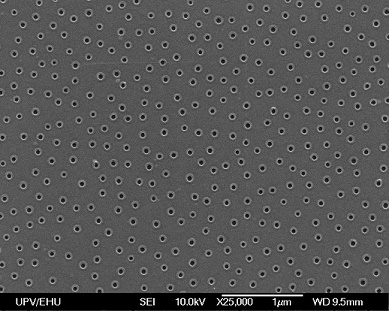BCMaterials oral presentation @ 5th Zing Bionanomaterials Conference

Meet our researchers at 5th Zing Bionanomaterials Conference on April 26th (11:50) in Algarve (Portugal), and learn about our latest Bio&Med advances contacting Maite Goiriena.


Permalloy nanodisks prepared by Colloidal Lithography for Biomedical Applications
M. Goiriena-Goikoetxea1, A. García-Arribas1,2, A. Svalov2 and M.L. Fdez-Gubieda1,2
1 BCMaterials, UPV/EHU, Barrio de Sarriena s/n, 48940, Leioa, Spain. 2 Departamento de Electricidad y Electrónica, UPV/EHU, Barrio de Sarriena s/n, 48940, Leioa, Spain. maite.goiriena@bcmaterials.net
Magnetic nanoparticles are extensively studied for biomedical applications because their size are comparable to biological entities, while providing remote capabilities of actuation1. Disk shaped ferromagnetic nanoparticles add attractive possibilities to these characteristics. First, Permalloy (Py) nanodisks display much higher saturation magnetization values than oxide nanoparticles and second, they can present a spin vortex configuration which leads to net zero magnetization at remanence, eliminating the problem of particle agglomeration. Therefore, Py nanodisks present a huge potential for biomedical applications, ranging from cancer cell destroy by hyperthermia or mechanical actuation (a low AC field makes the disk to oscillate damaging cell membrane and triggering the apoptosis) to MRI contrast enhancement and drug delivery2. Furthermore, we propose that nanodisks might cross cell membrane expanding the biomedical possibilities. While oxide nanoparticles are chemically synthetized, nanodisks physical fabrication methods offer higher control on particle size and geometry and the possibility of choosing among a larger spectrum of materials, i.e. electron beam lithography (EBL) and photolithography. These techniques, though, imply a very low yield production (in the case of EBL) and the use of sophisticated and expensive equipment. As an alternative, self-assembling routes provide high volume and low cost production of Py nanodisks. In this work we present the results obtained by Hole-mask Colloidal Lithography (HCL3). HCL utilizes the definition of a dense hole-pattern in a sacrificial resist layer onto which a layer of Py is deposited. Py disks with different sizes are produced after lift-off of the resist layer. The results obtained show promising structures. The magnetic characterization performed by Magneto-Optical Kerr Effect (MOKE) indicates that vortex-state is present4. The release of the nanodisks from the substrate is being optimized at this moment, with the consequent biofunctionalization and in vitro assays. 1 Q. A. Pankhurst et al., Journal of Physics D: Applied Physics, 2003, 167. 2 D.-H. Kim, et. al., Nature Materials, 2009, 9, 165. 3 Fredriksson et al., Advanced Materials, 2007, 19, 4297. 4 G. Shimon et al., Physical Review B, 2013, 87, 214422. [su_row][su_column size="1/2"]
Figure 1 : hole-patterned resist.
[/su_column][su_column size="1/2"]
Figure 2 : Permalloy nanodisks on SiO2 substrate.
[/su_column][/su_row] You can download the conference programme here.Related news
María Calles, nueva doctora de BCMaterials
Queremos felicitar a María Calles García por haber obtenido su doctorado en Ciencia y Tecnología de Materiales por la UPV/EHU. El 4 de diciembre María realizó una brillante defensa de su tesis...Charla invitada con investigadores del Instituto de Microelectrónica de Barcelona (3 de diciembre)
El próximo 3 de diciembre, a partir de las 12:00 en el auditorio Martina Casiano de Leioa, BCMaterials recibirá a los investigadores titulares del Instituto de Microelectrónica de Barcelona (IMB-CNM...Charla invitada con Liu Yao sobre baterías de metal-litio (2 de diciembre)
El próximo lunes 2 de diciembre, Liu Yao, profesor del Shanghai Institute of Applied Physics presentará una charla invitada en BCMaterials titulada ‘Li Metal Batteries: From Liquid to Solid-State’....Éxito del workshop anual de BCMaterials, dedicado a materiales críticos
La exitosa edición 2025 del workshop anual de BCMaterials reunió el pasado 19 de noviembre en Leioa a un centenar de asistentes para examinar el estado del arte y debatir sobre los materiales...



